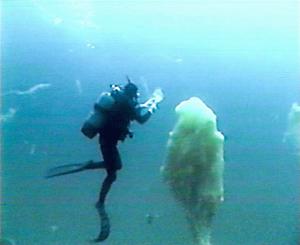Back in the day, a single giant sea-blob was enough to cause a stir. In fact, that’s just what happened last summer, when a huge, mysterious blob floated menacingly towards the Alaskan coast.
National Geographic, though, reports that blobs like these – called “mucilages” – are on  the rise:
the rise:
As sea temperatures have risen in recent decades, enormous sheets of a
mucus-like material have begun forming more often, oozing into new
regions, and lasting longer, a new Mediterranean Sea study says (sea “mucus” blob pictures).
And the blobs may be more than just unpleasant.
Up to 124 miles (200 kilometers) long, the mucilages appear naturally,
usually near Mediterranean coasts in summer. The season’s warm weather
makes seawater more stable, which facilitates the bonding of the
organic matter that makes up the blobs (Mediterranean map).Now, due to warmer temperatures, the mucilages are forming in winter too–and lasting for months.
[…] Mucilages aren’t a concern for just the Mediterranean, Danovaro added.
Recent studies tentatively suggest that mucus may be spreading
throughout oceans from the North Sea (map) to Australia, perhaps because of rising temperatures, he said.
It would certainly be unnerving to run into one of these. While they won’t devour you like the horror-film Blob, the article – which you can read here – notes that they “are hot spots for viruses and bacteria, including the deadly E. coli.“


![Reblog this post [with Zemanta]](http://img.zemanta.com/reblog_e.png?x-id=39c621e3-e12c-40fa-a95f-0671c65e9579)


![Reblog this post [with Zemanta]](http://img.zemanta.com/reblog_e.png?x-id=683080f5-e255-4b6e-9e24-f871dbf11248)


 least a handful of their own (my home state of Ohio has more than a dozen, including the interestingly-named
least a handful of their own (my home state of Ohio has more than a dozen, including the interestingly-named illnesses and injury, dates back at least 5,300 years (and is no doubt much older). During the Middle Ages and well into the Renaissance, herbalism was the cutting edge of medicine in Europe and elsewhere (even while the seeds of modern medicine were taking root in the Middle East).
illnesses and injury, dates back at least 5,300 years (and is no doubt much older). During the Middle Ages and well into the Renaissance, herbalism was the cutting edge of medicine in Europe and elsewhere (even while the seeds of modern medicine were taking root in the Middle East). 